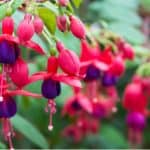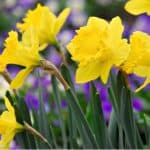Last updated on March 15th, 2022
Our site is reader supported, this means we may earn a small commission from Amazon and other affiliates when you buy through links on our site.
Planting bulbs is a great way to make sure your colourful, floral displays are able to welcome the spring, long before other plants have had a chance to awaken. Whether you plant in containers, borders, or in your lawn, you will find things like tulips, daffodils, snowdrops are wonderfully simple and offer a rewarding display. Things like where to plant, when to plant, and how deep the plant are all contingent somewhat upon the type of bulbs you have selected for your garden. Below we will explore all of this and more.
When do you Plant Bulbs?
Bulbs to create a display in spring should be planted most often in autumn, although some can be planted in spring, and these tend to be summer flowering bulbs. This is based on the type.
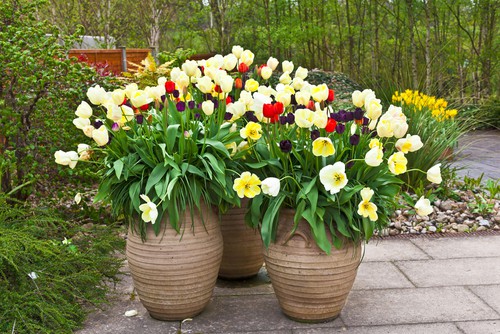
Below is a chart to help guide you on when to plant, based on what you are planting.
| Type | When to Plant |
| Allium bulbs | Autumn |
| Crocus bulbs | Autumn |
| Daffodil bulbs | Autumn |
| Bluebell bulbs | Spring or Autumn |
| Hyacinth bulbs | Autumn |
| Lily bulbs | Autumn |
| Narcissus bulbs | Autumn |
| Snowdrop bulbs | Spring or Autumn |
| Tree lily bulbs | Autumn |
| Tulip bulbs | Autumn |
The Best Soil for Bulbs
Well-drained soil, that doesn’t become waterlogged
The greatest thing about bulbs is the diversity found, and subsequently, the flexibility. There are bulbs you can plant for any soil type so you won’t have to focus so much on finding the right soil mixture, but rather, finding the right bulb for the soil you have.
Different species need different soils so you should figure out the precise requirements for the bulbs you are planting first. As a general rule though, they need well-drained soil so that they do not get waterlogged, particularly over winter.
Where to Plant Bulbs
Bulbs can be planted anywhere. You can place them in your garden right in the naturalised grass or lawn, or your containers, borders and some smaller spring-flowering bulbs like tete-a-tete daffodils work great in baskets because they come up through winter pansies. Still, no matter where you plant bulbs, be mindful of their sunlight requirements.
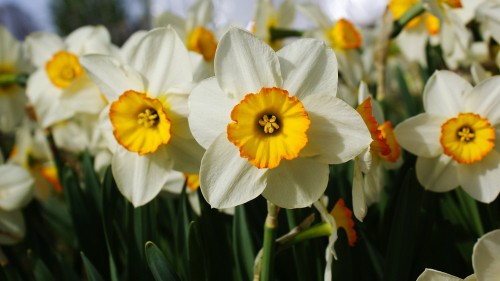
Again, the chart below should help shed some light, pun intended, on the preferred locations based on the bulb of choice:
| Bulb Type | Light requirements |
| Allium bulbs | Full sun |
| Crocus bulbs | Full sun or partial shade |
| Daffodil bulbs | Full sun or partial shade |
| Bluebell bulbs | Dappled shade |
| Hyacinth bulbs | Full sun or partial shade |
| Lily bulbs | Full sun or partial shade |
| Narcissus bulbs | Full sun or partial shade |
| Snowdrop bulbs | Dappled shade |
| Tree lily bulbs | Full sun or partial shade |
| Tulip bulbs | Full sun |
Planting Bulbs in Borders
When planting in borders, the bulbs should always be planted with the pointed, growing tip upright. If you are not sure which side is the top of the bulb, plant it on the side. Not all tuberous plants have an obvious growing point so you would do well to have the intended side upright, below the surface.
Planting Bulbs in Pots
If you are planting bulbs in pots, you have an easier time finding the right soil mixture and multipurpose compost is usually fine, or you can even bulb compost. You can pick and choose the bulbs you want most and then select appropriate potting soil from there if it’s specific. That being said, planting them in pots gives you the opportunity to easily move your flowers around the garden once they are in full bloom.
In fact, with containers you can move some of the early bloomers out of the way as they die back, making room for the late bloomers. It is best to use general purpose compost with some fine grit to aid in drainage. There are, however, bulb compost mixtures available as we have already mentioned if you so choose.
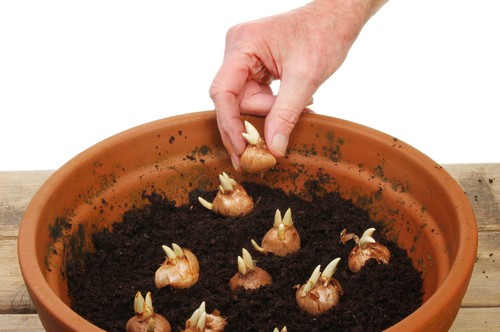
When planting bulbs in pots you should water them regularly as they are growing early on, and then water them regularly throughout flowering. Once the foliage starts to die back you can reduce the watering. If you go to battle against mice or squirrels, you can wrap chicken wire around your containers or pots to try and protect them. Squirrels have been known to dig bulbs up before they have sprouted so putting some wire over the top of pots early on is usually worthwhile if you have problems with squirrels.
Planting Bulbs in Grass
When you are planting bulbs in grass, you will find that bulbs grown in more informal areas are best because they can be left to their own devices without being mowed. To achieve the most natural look, it is best to gently scatter the bulbs across the area where you want them to grow, and then plant them wherever it is they land.
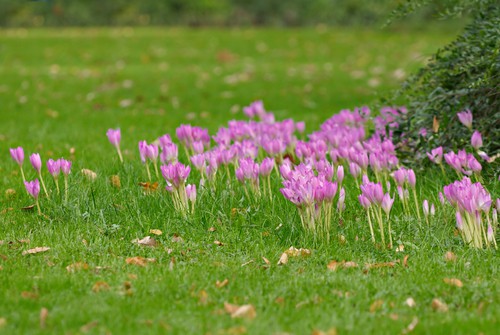
With a bulb planter, you can dig a hole that is the appropriate depth for the bulbs in question, and then drop the bulbs inside (making sure they are facing the right direction). Then cover them with soil and pack it down gently enough to remove air bubbles. Don’t walk across the grass area until they have grown in, otherwise, you might damage the tips.
If you are spreading the bulbs across a larger swath of land, it might be simpler to remove entire pieces of turf and then place the bulbs where you wish underneath before placing the turf back. Crocus and daffodils are both varieties that will grow well when planted under grass.
Planting Depths for Bulbs
The plant depth for the bulbs is based on the variety and species. As a general rule, you want to plant the bulb 2-3 times the height. For the most part, the depth should be between 10cm and 20cm and the spacing between bulbs is similar.
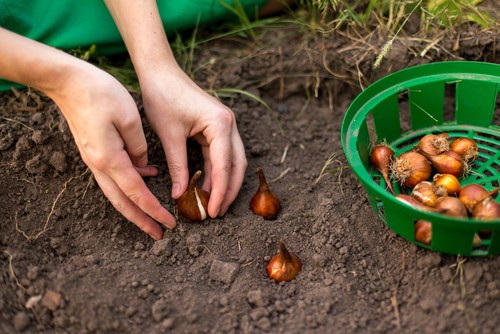
Below is a chart for quick reference, including some of the most common bulbs:
| Type | Depth | Distance |
| Allium bulbs | 10cm | 10cm |
| Crocus bulbs | 10cm | 7cm |
| Daffodil bulbs | 10cm | 10cm |
| Bluebell bulbs | 10cm | 10cm |
| Hyacinth bulbs | 10cm | 8cm |
| Lily bulbs | 20cm | 15cm |
| Narcissus bulbs | 10cm | 10cm |
| Snowdrop bulbs | 10cm | 10cm |
| Tree lily bulbs | 20cm | 15cm |
| Tulip bulbs | 15cm | 13cm |
Overall, bulbs are suitable for adding colour to borders, containers, or naturalised grasses. They come in all shades, from white to dark purple. Do not let the concept of a bulb frighten you away from growing the flowers you want most in your garden.
Tulips, scillas, even snowdrops (although it’s usually easier to plant them in the green) are among the easiest to plant. Summer flowering options like Lilies give tall and scented blooms while autumn flowering bulbs give your garden a delayed, colourful display. Moreover, if you are daring, you can rotate out the bulbs you bring home so that your garden becomes an almost year-round display of colour but this takes some planning.
Image credit – Shutterstock.com

